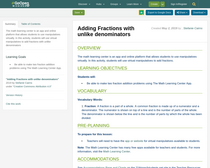Learning Domain: Number and Operations—Fractions
Standard: Understand a fraction 1/b as the quantity formed by 1 part when a whole is partitioned into b equal parts; understand a fraction a/b as the quantity formed by a parts of size 1/b. (Grade 3 expectations in this domain are limited to fractions with denominators 2, 3, 4, 6, and 8.)
Degree of Alignment:
Not Rated
(0 users)
Learning Domain: Number and Operations—Fractions
Standard: Understand a fraction as a number on the number line; represent fractions on a number line diagram. (Grade 3 expectations in this domain are limited to fractions with denominators 2, 3, 4, 6, and 8.)
Degree of Alignment:
Not Rated
(0 users)
Learning Domain: Number and Operations—Fractions
Standard: Compare two fractions with the same numerator or the same denominator, by reasoning about their size, Recognize that valid comparisons rely on the two fractions referring to the same whole. Record the results of comparisons with the symbols >, =, or <, and justify the conclusions, e.g., by using a visual fraction model. (Grade 3 expectations in this domain are limited to fractions with denominators 2, 3, 4, 6, and 8.)
Degree of Alignment:
Not Rated
(0 users)
Learning Domain: Number and Operations—Fractions
Standard: Understand addition and subtraction of fractions as joining and separating parts referring to the same whole.
Degree of Alignment:
Not Rated
(0 users)
Learning Domain: Number and Operations—Fractions
Standard: Solve word problems involving addition and subtraction of fractions referring to the same whole and having like denominators, e.g., by using visual fraction models and equations to represent the problem.
Degree of Alignment:
Not Rated
(0 users)
Learning Domain: Number and Operations—Fractions
Standard: Add and subtract fractions with unlike denominators (including mixed numbers) by replacing given fractions with equivalent fractions in such a way as to produce an equivalent sum or difference of fractions with like denominators. For example, 2/3 + 5/4 = 8/12 + 15/12 = 23/12. (In general, a/b + c/d = (ad + bc)/bd.)
Degree of Alignment:
Not Rated
(0 users)
Learning Domain: Mathematical Practices
Standard: Make sense of problems and persevere in solving them. Mathematically proficient students start by explaining to themselves the meaning of a problem and looking for entry points to its solution. They analyze givens, constraints, relationships, and goals. They make conjectures about the form and meaning of the solution and plan a solution pathway rather than simply jumping into a solution attempt. They consider analogous problems, and try special cases and simpler forms of the original problem in order to gain insight into its solution. They monitor and evaluate their progress and change course if necessary. Older students might, depending on the context of the problem, transform algebraic expressions or change the viewing window on their graphing calculator to get the information they need. Mathematically proficient students can explain correspondences between equations, verbal descriptions, tables, and graphs or draw diagrams of important features and relationships, graph data, and search for regularity or trends. Younger students might rely on using concrete objects or pictures to help conceptualize and solve a problem. Mathematically proficient students check their answers to problems using a different method, and they continually ask themselves, “Does this make sense?” They can understand the approaches of others to solving complex problems and identify correspondences between different approaches.
Degree of Alignment:
Not Rated
(0 users)
Learning Domain: Mathematical Practices
Standard: Model with mathematics. Mathematically proficient students can apply the mathematics they know to solve problems arising in everyday life, society, and the workplace. In early grades, this might be as simple as writing an addition equation to describe a situation. In middle grades, a student might apply proportional reasoning to plan a school event or analyze a problem in the community. By high school, a student might use geometry to solve a design problem or use a function to describe how one quantity of interest depends on another. Mathematically proficient students who can apply what they know are comfortable making assumptions and approximations to simplify a complicated situation, realizing that these may need revision later. They are able to identify important quantities in a practical situation and map their relationships using such tools as diagrams, two-way tables, graphs, flowcharts and formulas. They can analyze those relationships mathematically to draw conclusions. They routinely interpret their mathematical results in the context of the situation and reflect on whether the results make sense, possibly improving the model if it has not served its purpose.
Degree of Alignment:
Not Rated
(0 users)



Comments